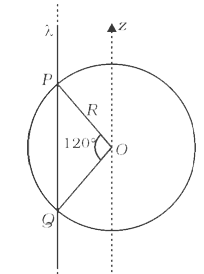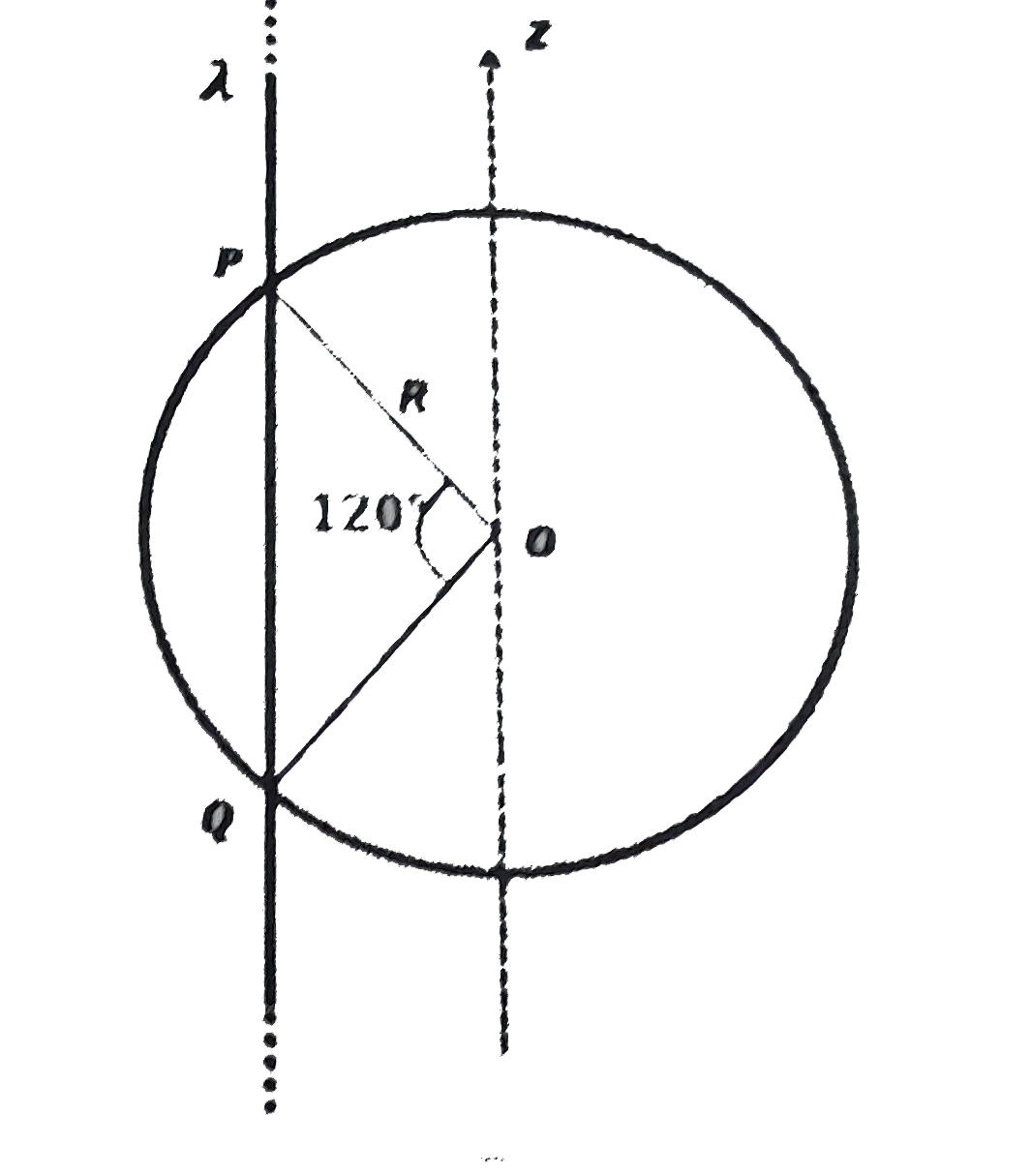An infinitely long thin non-conducting wire is parallel to the z-axis and carries a uniform line charge density λ. It pierces a thin non - conducting spherical shell of radius R in such a way that arc PQ subtends an angle 120∘ at the centre O of the spherical shell , as shown in the figure . The permittivity of the spherical shell , as shwon in the figure . The permittivity of free space is ∈0 . Which of the following statements is (are) ture ?

The electric flux through the shell is √3Rλ/ε0
The z-component of the electric field is zero at all the points on the surface of the shell
The electric flux through the shell is √2Rλ/ε0
The electric field is normal to the surface of the shell at all points
The correct Answer is:A, B
Step by step video & image solution for An infinitely long thin non-conducting wire is parallel to the z-axis and carries a uniform line charge density lambda. It pierces a thin non - conducting spherical shell of radius R in such a way that arc PQ subtends an angle 120^(@) at the centre O of the spherical shell , as shown in the figure . The permittivity of the spherical shell , as shwon in the figure . The permittivity of free space is in_(0) . Which of the following statements is (are) ture ? by Physics experts to help you in doubts & scoring excellent marks in Class 12 exams.
Topper's Solved these Questions
- BOOK - RESONANCE ENGLISHCHAPTER - ELECTROSTATICSEXERCISE - Part - II23videos
ELECTROSTATICS
- BOOK - RESONANCE ENGLISHCHAPTER - ELECTROSTATICSEXERCISE - HLP40videos
ELECTROSTATICS
- BOOK - RESONANCE ENGLISHCHAPTER - ELECTROSTATICSEXERCISE - Part - IV9videos
ELECTROSTATICS
- BOOK - RESONANCE ENGLISHCHAPTER - ELECTROMAGNETIC INDUCTIONEXERCISE - A.l.P19videos
ELECTROMAGNETIC INDUCTION
- BOOK - RESONANCE ENGLISHCHAPTER - EXPERIMENTAL PHYSICSEXERCISE - PART -II10videos
EXPERIMENTAL PHYSICS
Similar Questions
An infinitely long thin non-conduction wire is parallel to the z-axis and carries a uniform line charge density λ. It pierces a thin non-conducting spherical shell of radius r in such a way that that the are PQ subtends an angle 120∘ at the centre O of the spherical shell, as shown in the figure. The permittivity of free space is ε0. which of the following statements is (are) true ?
 View Solution
View SolutionA thin-walled spherical conducting shell S of radius R is given charge Q. The same amount of charge is also placed at its center C. Which of the following statements are correct?
View SolutionA non-conducting spherical shell of radius R surrounds a point charge q (q at center). The electric flux through a cap of the shell of half angle θ is:
View SolutionA non-conducting spherical shell of radius R surrounds a point charge q (q at center). The electric flux through a cap of the shell of half angle θ is:
View SolutionThe electric field at a distance 3R/2 from the centre of a charge conducting spherical shell of radius R is E. The electric field at a distance R/2 from the centre of the sphere is
View SolutionThe electric field at a distance 3R/2 from the centre of a charge conducting spherical shell of radius R is E. The electric field at a distance R/2 from the centre of the sphere is
View SolutionA thin spherical conducting shell of radius R has a charge q. Another charge Q is placed at the centre of the shell. The electrostatic potential at a point P a distance R2 from the centre of the shell is
View SolutionA thin spherical conducting shell of radius R has a charge q. Another charge Q is placed at the centre of the shell. The electrostatic potential at a point P a distance R/2 from the centre of the shell is
View SolutionA point charge Q is placed inside a conducting spherical shell of inner radius 3R and outer radius 5R at a distance R from the centre of the shell. The electric potential at the centre of the shell will be
View SolutionA point charge +q is placed at the centre of a conducting spherical shell of inner radius a and outer radius b. Find the charge appearing on the inner and outer surface of the shell.
View Solution
